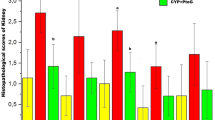Abstract
Cyclophosphamide (CP) is widely used, alone or in combination with other chemotherapeutic agents, for treatment of neoplastic diseases. Its urotoxicity may cause dose-limiting side-effects, for example hemorrhagic cystitis. The agent most often used to prevent this side-effect is mesna (2-mercaptoethane sulfonate). Overproduction of reactive oxygen species during inflammation is one reason for possible urothelial injury. The aim of this study was to evaluate whether combinations of quercetin and epigallocatechin 3-gallate (EGCG), flavonoid antioxidants and mesna could prevent cystitis induced by cyclophosphamide, better than mesna alone. A total of 38 male Sprague–Dawley rats were divided into five groups. Four groups received single dose of CP (100 mg kg−1) intraperitoneally at the same time. Group 2 received CP only, group 3 received mesna (3×21.5 mg kg−1), group 4 received a single dose of mesna+EGCG (2×20 mg kg−1), and group 5 received a single dose of mesna+quercetin (2×20 mg kg−1), before and after CP injection. Group 1 (not treated) served as control. CP injection alone resulted in severe cystitis. Mesna resulted in some, but not full, protection against CP toxicity. Quercetin and catechine, together with mesna, resulted in full protection against CP toxicity, on the basis of histopathology of the urinary bladder. It was concluded that oxidants might be important in the pathogenesis of CP-induced cystitis, and that flavonoid antioxidants, used in addition to mesna, may help to ameliorate bladder damage.


Similar content being viewed by others
References
Boyer J, Liu RH (2004) Apple phytochemicals and their health benefits. Nutrition J 3:5
Brown JE, Khodr H, Hider RC, Rice-Evans C (1998) Structural dependence of flavonoid interactions with Cu2+ ions: implications for their antioxidant properties. Biochem J 330:1173–1178
Cuzzocrea S, Reiter RJ (2001) Pharmacological action of melatonin in shock, inflammation, and ischemia/reperfusion injury. Eur J Pharmacol 426:1–10
Goren MP, McKenna LM, Goodman TL (1997) Combined intravenous and oral mesna in outpatients treated with ifosfamide. Cancer Chemother Pharmacol 40:371–375
Gray KJ, Engelmann UH, Johnson EH, Fishman IJ (1986) Evaluation of misoprostol cytoprotection of the bladder with cyclophosphamide (cytoxan) therapy. J Urol 133:497–500
Hanasaki Y, Ogawa S, Fukui S (1994) The correlation between active oxygens scavenging and antioxidative effects of flavonoids. Free Radic Biol Med 16:845–850
Korkmaz A, Oter S, Deveci S, Ozgurtas T, Topal T, Sadir S, Bilgic H (2003) Involvement of nitric oxide and hyperbaric oxygen in the pathogenesis of cyclophosphamide induced hemorrhagic cystitis in rats. J Urol 170:2498–2502
Kurovski V, Wagner T (1997) Urinary excretion of ifosfamide, 4-hydroxyfosfamide, 3- and 2-dechloroethylifosfamide, mesna, and dimesna in patients on fractionated intravenous ifosfamide and concomitant mesna therapy. Cancer Chemother Pharmacol 39:431–439
Levine AL, Richie PJ (1989) Urological complications of cyclophosphamide. J Urol 141:1063–1069
Mates JM, Perez-Gomez P, Nunez de Castro I (1999) Antioxidant enzymes and human disease. Clin Biochem 32:595–603
Oter S, Korkmaz A, Oztas E, Yildirim I, Topal T, Bilgic H (2004) Inducible nitric oxide synthase inhibition in cyclophosphamide induced hemorrhagic cystitis in rats. Urol Res 32:185–189
Park OJ, Surh YJ (2004) Chemopreventative potential of epigallocatechin gallate and genistein: evidence from epidemiological and laboratory studies. Toxicol Lett 150:43–56
Pietta PG (2000) Flavonoids as antioxidants. J Nat Prod 63:1035–1042
Ribeiro RA, Feritas HC, Campos MC, Santos CC, Figueiredo FC, Brito GA, Cunha FQ (2002) Tumor necrosis factor-α and interleukin-1β mediate the production of nitric oxide involved in the pathogenesis of ifosfamide induced hemorrhagic cystitis in mice. J Urol 67:2229–2234
Rotelli AE, Guardia T, Juàrez AO, de la Rocha NE, Pelzer LE (2003) Comparative study of flavonoids in experimental models of inflammation. Pharmacol Res 48:601–606
Szabo C (1996) The pathophysiological role of peroxynitrite in shock, inflammation, and ischemia-reperfusion injury. Shock 6:79–88
Topal T, Oter S, Korkmaz A, Sadir S, Metinyurt G, Korkmazhan ET, Serdar MA, Bilgic H, Reiter RJ (2004) Exogenously administered and endogenously produced melatonin reduce hyperbaric oxygen-induced oxidative stress in rat lung. Life Sci 75:461–467
Ursini F, Maiorino M, Morazzoni P, Roveri A, Pifferi G (1994) A novel antioxidant flavonoid (IdB 1031) affecting molecular mechanisms of cellular activation. Free Radic Biol Med 16:547–553
Vieira MM, Macedo FY, Filho JN, Costa AC, Cunha AN, Silveira ER, Brito GA, Ribeiro RA (2004) Ternatin, a flavonoid, prevents cyclophosphamide and ifosfamide-induced hemorrhagic cystitis in rats. Phytother Res 18:135–141
Virag L, Szabo E, Gergely P, Szabo C (2003) Peroxynitrite-induced cytotoxicity: mechanism and opportunities for intervention. Toxicol Let 141:113–124
West NJ (1997) Prevention and treatment of hemorrhagic cystitis. Pharmacother 17(4):696–706
Xu X, Malave A (2001) Protective effect of berberine on cyclophosphamide-induced haemorrhagic cystitis in rats. Pharmacol Toxicol 88:232–237
Yildirim I, Korkmaz A, Oter S, Ozcan A, Oztas E (2004). Contribution of antioxidants to preventive effect of mesna in cyclophosphamide-induced hemorrhagic cystitis in rats. Cancer Chemother Pharmacol 54(5):469–473
Yokozawa T, Rhyu DY, Cho EJ (2004) (−)-Epicatechin 3-O-gallate ameliorates the damages related to peroxynitrite production by mechanisms distinct from those of other free radical inhibitors. J Pharm Pharmacol 56(2):231–239
Acknowledgements
The “Gulhane Military Medical Academy Animal Care and Use Committee” approved the experimental procedures. All animals received care according to the criteria outlined in the “Guide for the Care and Use of Laboratory Animals” of the National Academy of Sciences and the National Institutes of Health. The experiments comply with current national laws.
Author information
Authors and Affiliations
Corresponding author
Rights and permissions
About this article
Cite this article
Ozcan, A., Korkmaz, A., Oter, S. et al. Contribution of flavonoid antioxidants to the preventive effect of mesna in cyclophosphamide-induced cystitis in rats. Arch Toxicol 79, 461–465 (2005). https://doi.org/10.1007/s00204-005-0647-7
Received:
Accepted:
Published:
Issue Date:
DOI: https://doi.org/10.1007/s00204-005-0647-7




